How safe are mooring balls? Risky enough that most seasoned cruisers avoid them at all costs, preferring to get a good nights sleep using their own well maintained and regularly inspected ground tackle.
But shouldn’t mooring balls be safer than anchoring? Yes, and no. In theory, mooring balls should be as safe or safer than anchoring. The problem is, most mooring balls, you cannot see what’s beneath the surface – and that’s where the potential for disaster is most likely. So your home is at the mercy of whoever last inspected the mooring ball and if the owner can afford to replace worn parts routinely.
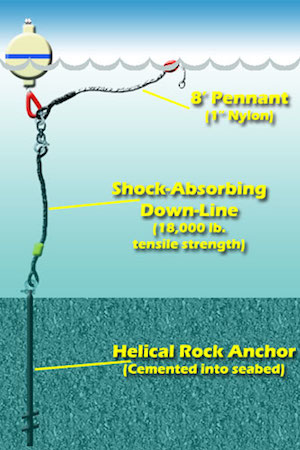 Here’s a diagram of a mooring ball from the City of Marathon (FL) Mooring Field. These mooring balls are installed with screw in anchors that go down several feet into the seabed. In looking at this diagram (a best case scenario in our experience), there are several spots with the potential for failure.
Here’s a diagram of a mooring ball from the City of Marathon (FL) Mooring Field. These mooring balls are installed with screw in anchors that go down several feet into the seabed. In looking at this diagram (a best case scenario in our experience), there are several spots with the potential for failure.
Anywhere there’s a connection is the most likely. So the connection from the ball to the chain/pennant, the connection to the anchor to the shock absorbing line right at the seabed and the connection of the pennant to the ball.
Several things are outside our control – we have no idea of the quality of the stainless steel used in the shackles – or if they even used stainless steel when they installed the balls. We have no idea what type of anchor was used in the seabed -we’ve seen a concrete block used, not substantial enough for our 12 ton boat. We also have no idea what type of shock absorbing line was used – or its condition. Line typically deteriorates quickly in salt water.
All of these add up to us preferring not to use a mooring ball – especially outside the USA.
So here are the things we do before we pick up a mooring …
1. Do a bit of research ahead of time. Find out who owns the mooring balls. Then ask a few questions:
How are they anchored?
What weight of boat is that anchor rated to hold?
How old are they?
How often are they inspected and by who? How often are parts replaced?
2. Given that you’re likely not going to get anything other than pat answers to your questions, it is your responsibility to determine if picking up the mooring ball is safe.
3. As you approach, visually access the condition of the ball and pennant. If anything looks rusty or jagged, don’t risk it. If the line looks frayed, don’t risk it. If what you see appears to be in good condition, pick up the pennant and run your line through it- loop it through and run it back to the same cleat – same side of the boat — see the post here on how to tie to a mooring ball. You’ll end up using two mooring lines – one for each side.
NEVER EVER run a single line through the pennant eye and back to the other side of the boat. If there is any rough edge on the pennant eye, normal swinging of the boat will saw right through your line. The only time we’ve had a mooring ball “break” was at pitch dark middle of the night at Josh Cay off Guanaja/Bay Islands. We never used mooring balls but at Josh Cay there was no room to anchor. We didn’t know then that it wasn’t OK to run a line through the eye and back to the other side of the boat. Sure enough we were left with two pieces of sawed in half mooring line dangling from cleats on either side of the boat. Luckily it was two miles across the channel to Guanaja, so we were drifting in a clear area. Good thing we woke up and realized it before we hit the reef along the other shore! YIKES!
4. Dive the mooring. If the water is too deep or not clear, you’ll have to inspect it as best you can and hope for the best.
In areas where moorings are common – the BVI, FL Keys, etc. they may be maintained better than out of the way areas. We literally never picked up a mooring ball anywhere in the Western Caribbean, except that one night at Josh Cay, which didn’t turn out so well.
But even in areas where mooring balls are common and maintained, it doesn’t mean they’re safe. Trust your own judgement and never tie up to a mooring you doubt.
Unfortunately in some areas of the world, such as the Mediterranean almost every mooring is rusty, jagged and required. Ugh. Pete Jackson tells us what s/v Argonauta did to solve the problem ….
We find many of the mooring rings here in the Mediterranean are very corroded and no matter how we feed lines through there is a risk of rough edges cutting the lines. as such we have made up a special line with 5mtrs of line spliced to 1mtr of chain then the other end of the chain spliced to a further 5mtrs of line. This way we can easily feed the line & chain through the eye and leave the chain at the eye whilst both lines are made off on the boat.
Other cruisers will likely be your most accurate source of information while cruising other areas of the world, so be sure to take advantage of local knowledge. Ask!
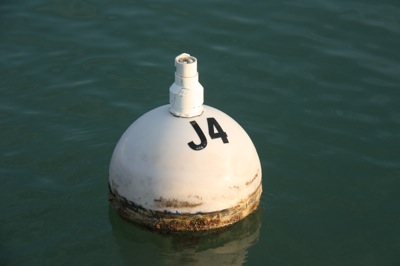
One of the most common problems with mooring balls is missing pennants. Pennants are not 100% crucial, but they make it easier to attach your boat to the mooring ball. In Naples, we asked ahead of time which mooring balls had pennants and were assured all had pennants. Sure enough when we arrived, there were no pennants and picking up a steel ring on top of a mooring ball is very difficult. Good thing there was no wind.
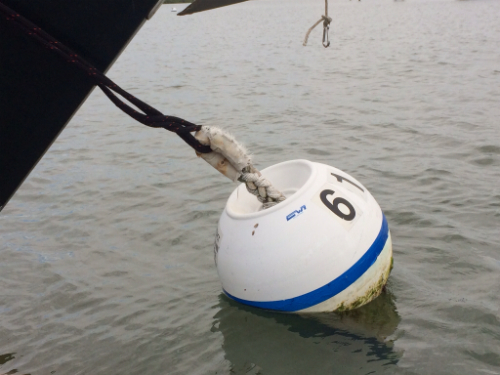
The moral of the story is, no matter how “trustworthy” the mooring balls, you are on your own to decide whether it’s safe for your boat. We’re still not comfortable when we’re not able to inspect our own mooring – but luckily in most places in the Florida Keys and the Bahamas, the shallow, clear waters allow a quick freediving inspection with merely snorkel gear.
We never set our anchor without checking it, don’t routinely attach to a mooring ball and assume it’s safe!
Anyone have more input on the safety of mooring balls in different areas? Please leave a comment and share! Thanks! Jan
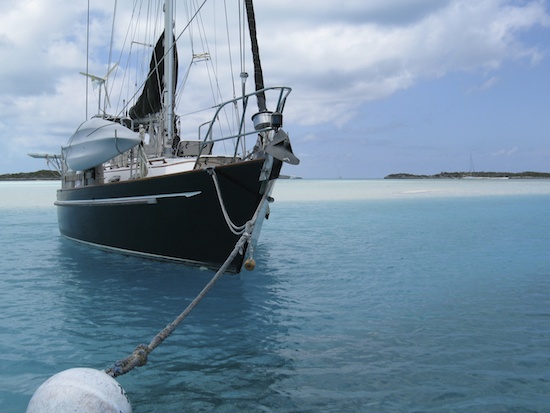
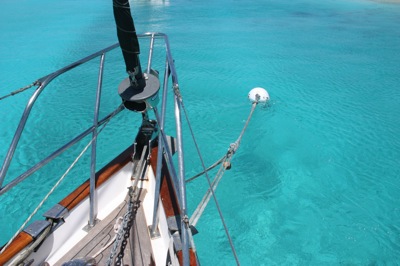











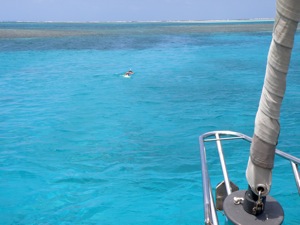

Good info. Great idea about splicing a couple of pieced of line onto a piece of chain, I gotta make up one of those, just to have onboard. For the life of me, I can’t figure out how to get the ball to not lay up against the hull when the wind and current are running opposite. It never fails, it seems to always happen when I’m sleeping, it’s morning, quiet so I’m able to sleep in a little, and then wham, thud thud thud thud. The only thing I’ve found that works, is to pull the pennant up on board, choking up on it so it’s straight down. I know the people running the moorings hate this, I know it’s not a good idea if the wind were to pick up, but I also know that I don’t want to trash the hull on the boat, I paid good money to have it painted right, and it’s held up really well over the last 11 years (PPG truck paint sprayed on, think about the fiberglass semi-trailers that have been out there for years getting beaten.), And, I know that a fender-board type thing wouldn’t work. Any ideas guys? Many thanks! Keith B
s/v Renasci
We have the same problem Keith B! We always end up with white mooring ball marks on our dark green hull. HATE! Anyone with solutions to a banging mooring ball when the wind & current oppose each other. Thx! Jan
Different conventions – Mine is the mooring chain moves through the mooring ball.
The rotator is below the connection so pull the chain up to the pulpit with a few feet of chain in the air and the mooring ball will never hit the vessel and the rotation is easy on the mooring location…with a “Y” if too long will go under the ball and lock up – if too short may damage vessel. Think about the pull and how you only swing around a center point and not big “O”. Get close to vessels with “Y” can strike.
Thought #2 for safety – and your living on the ball…Yes and you like to swim…take a 1/2 in line or larger – dive down and run through chain and secure to boat . Your vessel will rotate twice a day so untwisting is an every few day event, if you good it can be untwisted from above…this is like having a second line on your dink…extra work but makes for great
sleeping.
One always is learning on the BALL – Ground tackle that is another story
GOD Speed – Page
Do you ever back down on a mooring like you would to set an anchor to test its strength? Seems like a easy and quick test. Nubie sailors here, never moored before.
Never backed down on a mooring ball, may dive on it especially outside the US. Is it in a mooring field maintained by US “standards”. We trust our anchor much more than a mooring but never have trouble sleeping in places like Boot Key Harbor. Cheers! Jan
PS David says it’s a nigger concern how you hook to the ball. The only time we’ve had trouble with a mooring (in Honduras) was when our line chafed through in the middle of the night.
I hope you meant to type ‘bigger’ concern… =:-0